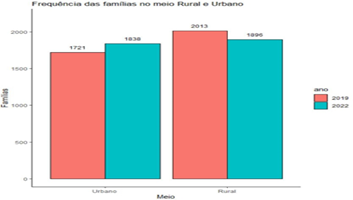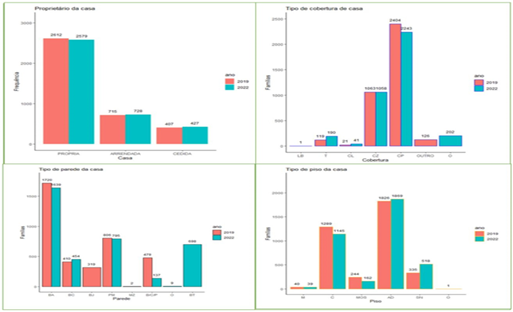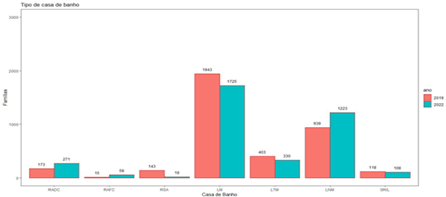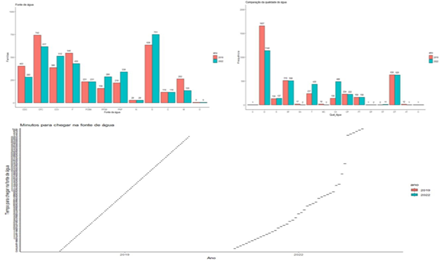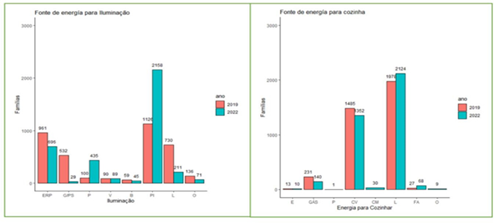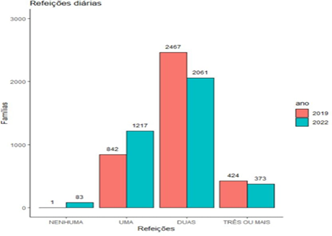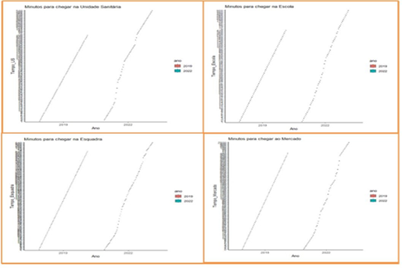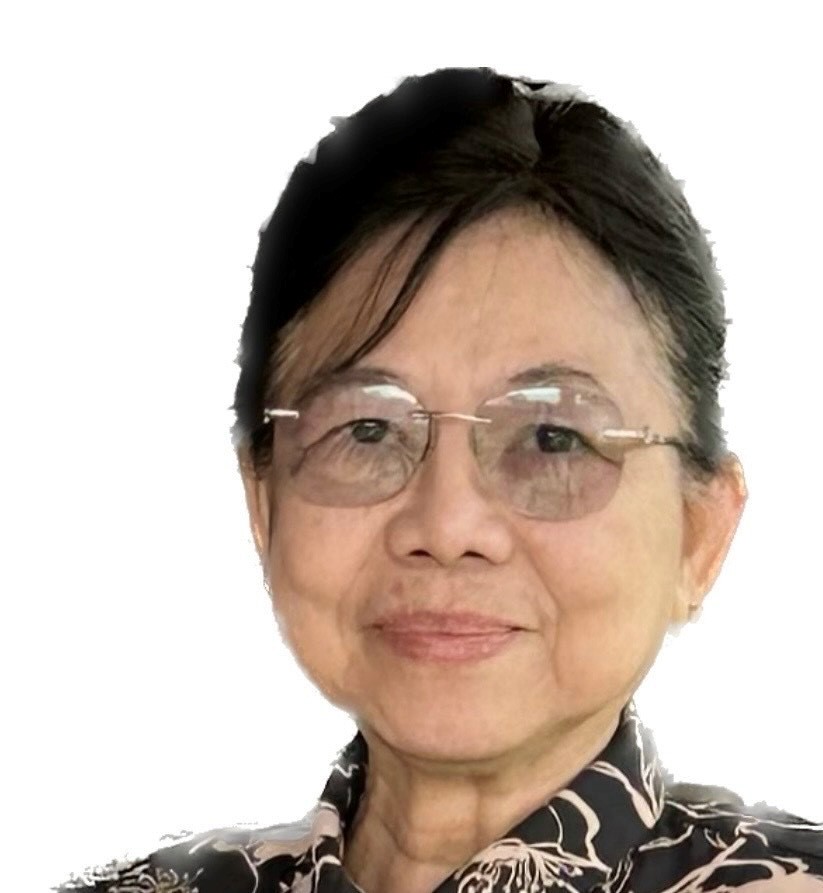Review Article
Evolution of Living Conditions in the Province of Niassa, Mozambique: A Comparison between 2019/22
1PhD student in Mathematical Engineering, Statistics and Operational Research, Complutense University of Madrid, Madrid, Spain. 2Department of Economic Statistics, Niassa Delegation, National Institute of Statistics, Mozambique.
*Corresponding Author: Aliyu Evuti Haruna, PhD student in Mathematical Engineering, Statistics and Operational Research, Complutense University of Madrid, Madrid, Spain.
Citation: Oclidio F. Tete, Lourenco P. (2025). Evolution of Living Conditions in the Province of Niassa, Mozambique: A Comparison between 2019/22. Journal of BioMed Research and Reports, BioRes Scientia Publishers. 7(3):1-12. DOI: 10.59657/2837-4681.brs.25.136
Copyright: © 2025 Oclidio Francisco Tete, this is an open-access article distributed under the terms of the Creative Commons Attribution License, which permits unrestricted use, distribution, and reproduction in any medium, provided the original author and source are credited.
Received: January 29, 2025 | Accepted: February 27, 2025 | Published: March 12, 2025
Abstract
This study analyzes the evolution of living conditions of families in Niassa Province, Mozambique, between 2019 and 2022. Based on indicators of quality of life and access to basic services, the research assessed crucial dimensions such as the quality of water consumed, access to public services, food standards, housing conditions and employment opportunities. The results highlight significant changes in several indicators, revealing advances and challenges within the socioeconomic context of the region. This work contributes to a deeper understanding of the dynamics of living conditions in Niassa and provides valuable insights for the formulation of public policies aimed at sustainable and inclusive development.
Keywords: niassa; living conditions; sustainable development; basic services
Introduction
The living conditions of the population represent one of the main indicators of the socioeconomic development of a region. In developing countries, such as Mozambique, understanding these conditions is essential for formulating external public policies to reduce social inequalities and promote well-being. Niassa Province, located in the north of the country, faces significant challenges related to poverty, unequal access to basic services and precarious living conditions. This study aims to analyze the evolution of the living conditions of families in the Province of Niassa, based on indicators of quality of life and access to essential services between 2019 and 2022. The research addresses fundamental issues, such as the quality of water consumed, access to public services (such as hospitals, schools, police stations and markets), dietary standards, housing conditions and access to employment, seeking to identify advances, setbacks and persistent inequalities. Throughout the work, quantitative data from 2019 and 2022 databases were used, allowing for a detailed comparative analysis. Thus, this study not only provides an updated view of the province's socioeconomic reality, but also highlights relevant aspects for the formulation of public policies that promote sustainable and inclusive development.
Problematization
Niassa Province, Mozambique, faces historical challenges related to poverty, limited access to basic services and social inequalities. Despite government and international efforts to improve living conditions, the question remains: What significant changes have there been in the living conditions of the population of Niassa between 2019 and 2022, and to what extent have public and social interventions developed to address these changes?
Motivation and Justification
This study was motivated by the need to understand the dynamics of living conditions in Niassa Province, one of the most vulnerable regions in Mozambique. Understanding the changes between 2019 and 2022 is crucial to identify progress, setbacks and areas that require urgent interventions. The results can support policy decisions, resource allocation and evaluation of existing public policies. The rationale for the study is based on the importance of providing empirical data on quality-of-life indicators, such as access to safe water, energy, food and housing. In addition, this work will contribute to national and international efforts to monitor the Sustainable Development Goals (SDGs), especially SDG 1 (no poverty) and SDG 6 (access to clean water and sanitation).
Theoretical Foundation
Inequality and Poverty
Nascimento Cruz et al. [2015] characterizes inequality based on the conditions offered to the population, stating that when offered, they differ in the degree of quality and effectiveness depending on the social subjects who will benefit. For Nascimento Cruz et al. [2015], inequality can be described as an imbalance in the standard of living of a given population, present in undeveloped and underdeveloped countries where income distribution occurs disproportionately. Araújo [2017] states that inequality is a phenomenon with multiple dimensions, which concerns the unequal conditions to which different social groups are subjected in terms of their ability to satisfy their basic needs, the fulfillment of their rights, among other factors. It concerns the contrast between a group of people who hold large amounts of wealth, social and material capabilities to meet their needs and have their rights assured and another group of people with insufficient income, without the conditions to satisfy their basic needs, without access to essential services and deprived of basic rights. As for the concept of poverty, it is something very complex, according to Costa [2014] and Mague-nhe [2016] they define poverty as a human condition characterized by sustained or chronic deprivation of resources, capabilities, choices, security and power necessary for the enjoyment of an adequate standard of living and other civil, cultural, economic, political and social rights. Additionally, and sharing the idea of authors, Truzão [2013], Zitha [2012], among others, argue that the concept of poverty encompasses several faces that require understanding based on the theoretical and methodological approaches that conduct each research in a given context. . Therefore, the notion of poverty in the present work must be seen as being the set of socioeconomic factors as well as the ways of interpreting this phenomenon and how the individual perceives their own social situation.
Multidimensional Poverty
Multidimensional poverty is a model for assessing poverty in which monetary income is considered a variable that determines the degree of deprivation of an individual or family. Multidimensional poverty is structured on concepts such as functionings, capabilities and deprivations according to Kerstenetzky [2000]. The Alkire-Foster methodology (AF), one of the most widely used methodologies internationally to measure multidimensional poverty, was developed by Sabina Alkire and James Foster. It differs from traditional measures of poverty that are based only on income and consumption, by considering several dimensions of deprivation simultaneously, such as education, health, access to basic services, adequate housing, among others.
Urban and Rural Development
de Oliveira et al. [2014] discusses connections between urbanization and ruralization processes, emphasizing the importance of an integrated approach to sustainable development. de Oliveira et al. [2014] argues that urban and rural dynamics cannot be treated in isolation, as they influence and shape socioeconomic reality in an interdependent manner. He highlights that in an increasingly urbanized world, rural development should be considered as an extension of urban policies, promoting social inclusion and environmental preservation. de Oliveira et al. [2014] analyzes the challenges faced by rural areas such as migration to other urban centers and the need for adequate infrastructure, proposing solutions that involve community participation and the use of appropriate technologies. This critical perspective is fundamental to understanding development in contemporary contexts where the boundaries between rural and urban become increasingly fluid. Sant'anna et al. [2011] discusses several theories and approaches related to rural development, critically analyzing traditional models and proposing a more integrated vision that considers social, economic and environmental dimensions. This author emphasizes the importance of community participation and the valorization of local knowledge, arguing that rural development should be an inclusive and sustainable process. The author criticizes approaches that prioritize only economic growth, suggesting that true development should consider the quality of life of rural populations and the preservation of natural resources. These ideas contribute to a broader and multidimensional understanding of rural development, aligning with other contemporary currents that seek alternatives to the hegemonic model of development.
Sustainable Development
According to Serra [2017], the theory of sustainable development is not just limited to economic growth, but involves the promotion of freedom and human capabilities, social, political and environmental aspects. He argues that the true measure of a society's development is the extent to which its people have the freedom to live the lives they value, and highlights the importance of social justice and equality of opportunity that benefits all people.
Urbanization and Spatial Inequality
According to Giacobbo [2021], spatial inequality in cities is a reflection of market forces and government policies that favor certain groups over others. He highlights that urbanization and spatial inequality influence the urban structure and the distribution of power and resources within cities. Santos [2017], argues that cities are places where both opportunities and inequalities are concentrated, and that the way urban space is organized reflects and perpetuates social and economic divisions. He discusses how urban expansion, gentrification, residential segregation and lack of access to basic services contribute to the creation of territories marked by inequality. According to Carlos [2020], urban space is a field of conflicts and contradictions, where different interests and actors dispute control and use of the territory. The right to the city represents not only physical access to urban spaces but also the possibility of actively participating in their production and transformation. It defends the idea of urbanization centered on the needs and aspirations of citizens, promoting social justice, participatory democracy and quality of life for all.
Sanitation and Public Health
According to Chadwick [1942], sanitation and public health theory is based on the belief that poor hygiene and sanitation conditions are responsible for the spread of disease and the deterioration of population health. He advocated the idea that improving sanitary conditions, including clean water supplies, waste treatment, and adequate drainage, was essential to preventing disease and promoting health. It emphasizes the importance of government intervention and the implementation of public policies to guarantee access to healthy living conditions for all citizens. He also argues that investing in sanitation and public health measures would not only benefit the population but would also bring economic and social benefits to society as a whole.
Food Safety
According to Sen [1981], food insecurity is not only a result of food shortages, but is more related to access to these foods, which he calls priority rights. He highlights the importance of economic and social conditions that allow people to acquire food and not just the physical availability of food. This perspective revolutionized the way food security is understood, emphasizing the need for policies that guarantee access and not just the supply of food. According to Henrique et al. [2016], communities can develop appropriate practices and rules to manage their own food sources, promoting resilience and self-sufficiency. Active community participation in food resource management is essential to face challenges such as food scarcity and climate change, reflecting the importance of collective actions in promoting food security. According to Pharr [2000], the decrease in participation in community activities and the weakening of social networks negatively impact access to information, economic opportunities and social support, thus exacerbating existing inequalities. For Sen and Dreze [1999], development must be seen not only as economic growth but as a process of expanding people's freedoms and capabilities. It discusses how access to resources and opportunities are key to reducing inequality, including in rural areas where living conditions can be challenging. The same author emphasizes the importance of considering individual capabilities and the barriers that people face, including social, economic and political factors that affect access to essential goods and services.
Social Inclusion
According to Sen and Dreze [1999], true development should not be measured solely by economic growth, but also by people’s ability to lead lives they value. For them, social inclusion is essential to ensure that everyone has access to the opportunities and resources needed to realize their potential. Sen and Dreze [1999] introduce the concept of capabilities, which refers to the real freedoms that individuals have to choose the way of life they want. Social inclusion in this context implies eliminating barriers that prevent people from exercising their capabilities, such as poverty, discrimination, and lack of access to education and health. Thus, Sen and Dreze [1999] highlight the importance of public policies that promote equity and social justice, aiming at holistic and sustainable development. For Fernandes et al. [2010], the importance of valuing and recognizing the diverse forms of knowledge and experiences that exist in societies defends an inclusive perspective that seeks to combat social inequalities and promote social justice. He criticizes the hegemonic view of knowledge and proposes the need for a sociology of absences, where marginalized voices and experiences are heard and valued. The philosopher Walzer [2008] argues that justice must be understood in different social spheres, each with its own norms and values. He advocates the inclusion of diverse cultures and groups within a pluralistic society. The work highlights the importance of recognize and respect differences, promoting a form of justice that takes into account the specific realities of each social group.
Methodology
This study is based on data from the Household Budget Survey (IOF), conducted by the National Institute of Statistics (INE) of Mozambique, for the years 2019 and 2022. The databases are national, have data that include 259 variables and 70,470 observations (families that responded to the IOFs). From these databases, a filter was made and sub- bases were created with only families from the Niassa Province, which was our focus of study. The sub-bases had 3,734 observations. Regarding the variables, the study was based on variables related to housing (type and conditions of housing), water quality, food (number of daily meals and value corresponding to the meal) and access to basic services (health, school, security, transport and market). The analysis was conducted using descriptive statistical methods, which were used to summarize the main variables in each year. In addition, data visualization techniques were used/applied to facilitate the interpretation of the results. The analyses were performed using statistical software, SPSS (the format in which the databases were acquired) and R (the software used for analysis), ensuring accuracy in data manipulation and generation of results. This procedure allowed for a robust comparison of living conditions between the two periods analyzed (2019 and 2022), highlighting significant changes and their implications for public policies.
Data Analysis and Presentation
The analysis of the distribution of the sample between urban and rural areas in 2019 and 2022 provides important insights into the living conditions and socioeconomic context of families in Niassa Province. The graph in Figure 1 shows that in 2019, the sample included 1,721 families in urban areas and 2,013 in rural areas, reflecting a greater concentration of families in rural areas, a predominant characteristic of the province’s demographics. In 2022, there was an increase in the number of families interviewed in urban areas, which rose to 1,838, while in rural areas this number decreased slightly to 1,896. The growth in the urban sample may be related to the progressive urbanization observed in many regions of Mozambique, driven by factors such as migration in search of better employment opportunities, basic services and infrastructure. However, the reduction in rural representation in 2022 suggests that the sample may reflect changes in the scope or focus of data collection policies, as well as potential logistical challenges in reaching more remote communities. This distribution is also crucial to understanding the disparities between the two contexts. As noted previously, aspects such as basic sanitation, access to drinking water, energy and housing conditions show marked differences between urban and rural areas. Urban areas tend to have greater access to infrastructure, while rural areas face greater challenges, such as longer distances to access essential services and greater dependence on traditional materials and natural resources for housing and energy. The representativeness of the sample in both contexts is essential to assess the impact of public policies and identify specific priorities. While urban areas may require improvements in the quality and accessibility of basic services, rural areas require interventions that reduce structural inequalities and promote integrated development. The changes in the numbers between 2019 and 2022 reinforce the importance of disaggregated analyses to capture the specificities of each context and better guide development actions in the Province of Niassa.
This study is based on data from the Household Budget Survey (IOF), conducted by the National Institute of Statistics (INE) of Mozambique, for the years 2019 and 2022. The databases are national, have data that include 259 variables and 70,470 observations (families that responded to the IOFs). From these databases, a filter was made and sub- bases were created with only families from the Niassa Province, which was our focus of study. The sub-bases had 3,734 observations. Regarding the variables, the study was based on variables related to housing (type and conditions of housing), water quality, food (number of daily meals and value corresponding to the meal) and access to basic services (health, school, security, transport and market). The analysis was conducted using descriptive statistical methods, which were used to summarize the main variables in each year. In addition, data visualization techniques were used/applied to facilitate the interpretation of the results. The analyses were performed using statistical software, SPSS (the format in which the databases were acquired) and R (the software used for analysis), ensuring accuracy in data manipulation and generation of results. This procedure allowed for a robust comparison of living conditions between the two periods analyzed (2019 and 2022), highlighting significant changes and their implications for public policies.
Data Analysis and Presentation
The analysis of the distribution of the sample between urban and rural areas in 2019 and 2022 provides important insights into the living conditions and socioeconomic context of families in Niassa Province. The graph in Figure 1 shows that in 2019, the sample included 1,721 families in urban areas and 2,013 in rural areas, reflecting a greater concentration of families in rural areas, a predominant characteristic of the province’s demographics. In 2022, there was an increase in the number of families interviewed in urban areas, which rose to 1,838, while in rural areas this number decreased slightly to 1,896. The growth in the urban sample may be related to the progressive urbanization observed in many regions of Mozambique, driven by factors such as migration in search of better employment opportunities, basic services and infrastructure. However, the reduction in rural representation in 2022 suggests that the sample may reflect changes in the scope or focus of data collection policies, as well as potential logistical challenges in reaching more remote communities. This distribution is also crucial to understanding the disparities between the two contexts. As noted previously, aspects such as basic sanitation, access to drinking water, energy and housing conditions show marked differences between urban and rural areas. Urban areas tend to have greater access to infrastructure, while rural areas face greater challenges, such as longer distances to access essential services and greater dependence on traditional materials and natural resources for housing and energy. The representativeness of the sample in both contexts is essential to assess the impact of public policies and identify specific priorities. While urban areas may require improvements in the quality and accessibility of basic services, rural areas require interventions that reduce structural inequalities and promote integrated development. The changes in the numbers between 2019 and 2022 reinforce the importance of disaggregated analyses to capture the specificities of each context and better guide development actions in the Province of Niassa.
Figure 1: Families in Rural and Urban Areas
Source: Authors
The analysis of housing conditions in Niassa Province between 2019 and 2022 highlights important changes in housing characteristics and ownership. In the graphs Figure 2 shows that in 2019, most families lived in their own homes, while a smaller portion lived in rented homes and in homes that were ceded or inherited. This scenario reflects a predominance of self-sustained housing, characteristic of rural and semi-urban areas in the region. However, in 2022, there was a decrease in the number of families living in their own homes, accompanied by an increase in ceded/inherited homes, suggesting a worsening of economic conditions that limit families' ability to maintain or acquire their own properties. As for the roof of houses, in 2019, most houses had grass roofs, followed by the use of zinc sheets and, to a lesser extent, tiles. This pattern reveals the predominance of traditional and accessible materials, which are widely used due to their local availability and reduced cost. However, the choice of roofing material partly reflects the socioeconomic conditions of families, since zinc sheets and tiles are more durable options and are often associated with better living conditions. The walls of the houses also had distinct characteristics in 2019, with the majority being built from matope blocks, a traditional material obtained locally, followed by wattle and daub walls and a smaller number of buildings made from cement blocks. These characteristics reflect a reliance on natural and low-cost materials, which are still prevalent in rural areas. However, the use of cement blocks, although less frequent, indicates a trend towards modernization in some localities. Regarding the flooring of homes, in 2019, the majority of homes had floors covered in grass, followed by cement floors. A smaller number of houses had mosaic floors, while others did not have any type of covering. This distribution highlights inequalities in access to more durable construction materials and the difference in living conditions between families of different socioeconomic levels. In 2022, the drop in the number of homes owned may be associated with changes in materials or the degradation of housing conditions. These data highlight the need for housing policies aimed at improving housing conditions, promoting the use of more durable and affordable materials, as well as encouraging the construction of homes. In addition, it is essential to strengthen initiatives that increase access to economic resources and housing financing programs, to enable families to maintain or improve their living conditions.
The changes observed between 2019 and 2022 reflect the economic and structural challenges faced by the populations of Niassa Province, highlighting the urgency of public interventions to reduce housing inequalities.
Figure 2: House type
Source: Authors
The analysis of basic sanitation conditions in the Province of Niassa between 2019 and 2022 reveals significant changes in the use of sanitation facilities by families. The graph in Figure 3 shows that in 2019, the majority of families used improved latrines, followed by those that used non-improved latrines. In third place were families using improved traditional latrines, while a smaller number had indoor sanitary toilets, with or without flushing. However, there was also a significant number of families without access to any type of bathroom, who resorted to the open air or used facilities in neighboring houses. The scenario in 2022 points to a worsening in sanitation conditions. There was a decrease in the number of families with access to improved latrines, as well as those using improved traditional latrines. On the other hand, there was an increase in the number of families that began to depend on unimproved latrines, in addition to an increase in the number of families without access to any type of latrine, which indicates a setback in basic hygiene and sanitation conditions in the region. This worsening situation possibly reflects economic hardships faced by families, as well as limitations on investments in basic sanitation infrastructure. The reduction in the use of improved latrines and the increase in open defecation practices represent a high risk to public health, contributing to the spread of waterborne and infectious diseases, such as diarrhea and parasitic infections, especially in rural areas and more vulnerable communities. Given this scenario, it is urgent to implement public policies aimed at expanding and improving sanitation conditions in the Province of Niassa. This includes promoting access to safe sanitation facilities, encouraging the use of affordable technologies for improved sanitation, and raising awareness among communities about the importance of basic sanitation for health and well-being. The setback observed between 2019 and 2022 highlights the need for joint efforts between governments, non-governmental organizations, and communities to ensure universal access to decent hygiene and sanitation conditions.
Figure 3: Type of latrine used
Source: Authors
The comparative analysis of access to drinking water between 2019 and 2022 in Niassa Province reveals significant changes in the supply sources used by families. The graphs in Figure 4 show that in 2019, most families obtained water from piped sources outside their homes, followed by the use of surface water, such as rivers, lakes and ponds. A smaller number used piped water inside their homes, while a small proportion depended on sources in neighboring homes and other families consumed mineral water. In 2022, there was a worrying increase in the number of families that began to depend on surface water and unprotected wells, while the use of piped sources, both inside and outside homes, as well as fountains and mineral water, decreased. The increase in the use of water from unprotected surfaces and wells is a clear indicator of a decline in access to safe drinking water sources. These resources, although accessible in terms of proximity, are generally of poor quality and are vulnerable to contamination by waste, sewage, and human or animal activities. On the other hand, the decrease in the use of piped sources inside or outside the home suggests difficulties related to the maintenance and expansion of water infrastructure, possibly compounded by economic and administrative challenges. Regarding the quality of water consumed, in 2019, the majority of families had access to fresh water, while a smaller portion resorted to turbid water contaminated by plants and animals, especially in rural areas where water supply depended on surface sources.
In 2022, the situation worsened, with a reduction in freshwater consumption and a significant increase in the use of turbid and contaminated water. This change directly impacts public health, increasing the risk of waterborne diseases such as diarrhea and cholera, especially among children and other vulnerable populations. Another worrying aspect is the increase in the distances traveled by families to access water sources in 2022. While in 2019 the sources were relatively close, allowing families to save time and energy in their search for water, in 2022 these distances increased considerably. This change reflects not only the deterioration of local sources, but also the impact of the lack of investment in decentralized and efficient water supply systems. The need to travel longer distances to fetch water has significant social and economic implications. In many cases, this task falls primarily on women and children, who lose valuable time that could be devoted to other activities, such as study, work or leisure. In addition, the additional physical effort contributes to the physical and emotional exhaustion of these populations, further increasing their vulnerability. The data analyzed reinforce the urgent need for public policies aimed at expanding and improving access to drinking water in Niassa. Investments in the construction of safe supply systems, such as protected wells and distribution networks, are essential to reduce dependence on unsafe sources and improve the quality of life of families. In addition, it is essential to implement awareness programs on the safe and sustainable use of water, as well as strategies to bring water sources closer to communities, promoting local development and ensuring access to a resource essential for survival.
Figure 4: Source and type of water
Source: Authors
The analysis of the use of energy sources for lighting and cooking in the Province of Niassa between 2019 and 2022 reveals significant changes in household consumption patterns, reflecting both the limitations of access to modern sources and the impact of the increase in the cost of living. The graph in Figure 5 shows that in 2019, most households used batteries (PI) for lighting, followed by the use of energy from the public grid (ERP), and, to a lesser extent, solar panels (G/PS). In 2022, the scenario changed drastically, with a significant increase in the use of batteries for lighting and a significant reduction in the use of energy from the public grid and firewood. In addition, there was a considerable increase in the use of petroleum (P) as an alternative for lighting. The growth in the use of batteries as a primary source of energy for lighting can be attributed to the lack of reliable access to the public electricity grid and the escalating costs associated with electricity. This shift reflects an increasing reliance on portable and easily available energy sources, although these are less sustainable in the long term. On the other hand, the reduction in the use of energy from the public grid suggests challenges related to the electricity infrastructure, including frequent outages, rising energy rates, or difficulty in expanding the reach of the grid to more remote areas. In the context of the energy source for cooking, data show that in 2019, firewood (L) was widely used as the main energy source, followed by charcoal (CV) and, to a lesser extent, cooking gas. In 2022, the use of firewood for cooking increased further, while the consumption of charcoal and gas decreased significantly. Interestingly, there was an increase in the use of animal feces (AF) as an energy source for cooking, highlighting the search for low-cost alternatives amid adverse economic conditions. The increase in the use of firewood and animal feces for cooking can be explained by the relative accessibility of these sources in rural areas, where many families depend on locally available natural resources. However, this pattern of energy consumption has serious environmental and social consequences, such as deforestation and exposure to domestic air pollutants, which affect the health of families, especially women and children, who are generally responsible for to cook. On the other hand, the decrease in the use of charcoal and gas suggests that these energy sources have become economically unviable for many families, due to rising prices and the lack of subsidies or programs that promote access to cleaner fuels. This change is worrying, as it indicates a setback in access to safer and more efficient energy sources, compromising efforts to improve quality of life and reduce environmental impacts. These changes in energy consumption patterns for lighting and cooking highlight the urgent need for public policies that encourage the use of renewable and sustainable energy sources, such as solar panels and biogas, in addition to promoting the expansion of the public electricity grid in Niassa. The rising cost of living combined with dependence on traditional sources reflects a situation of energy vulnerability that requires coordinated actions to ensure universal access to clean and affordable energy, as provided for in the global sustainable development goals.
Figure 5: Energy for lighting and cooking
Source: Authors
A comparative analysis of data on household eating habits in Niassa Province between 2019 and 2022 shows a significant deterioration in access to food, reflecting the increase in the cost of living and the decrease in purchasing power. The graph in Figure 6 shows that in 2019, most families were able to have two meals a day, while a smaller portion depended on just one meal and, to a lesser extent, there were families that were able to eat three or more times a day. However, the situation worsened considerably in 2022. The most recent data (2022) shows an alarming increase in the number of families that no longer have a single meal a day, indicating situations of severe food insecurity. At the same time, there has been a substantial increase in families surviving on just one meal a day. This change reflects not only the lack of physical and economic access to food, but also the impacts of external factors, such as rising prices of essential goods, unemployment and reduced disposable income. The decline in the number of families that are able to eat two or more meals a day is a clear indicator that living conditions have deteriorated. The reduction in meal frequency directly affects the health and productivity of the population, especially children, who are more vulnerable to malnutrition and diseases associated with the lack of essential nutrients. In addition, reduced access to food may be related to economic crises, instability in the supply of products and changes in agricultural production patterns. These data reinforce the conclusion that the cost of living has increased significantly for families in Niassa between 2019 and 2022. The increase in the price of basic foods, combined with lack of infrastructure and efficient social support policies, worsens existing inequalities and exposes the most vulnerable families to even more precarious conditions. To address this In this situation, it becomes essential to implement food security programs and interventions aimed at reducing the costs of essential goods and increasing family income.
Figure 6: Number of daily meals
Source: Authors
For access to basic services, such as health centers, schools, markets and police stations, it reveals a deterioration in conditions between 2019 and 2022. In the graphs in Figure 7, it is observed that in 2022 families reported traveling significantly greater distances and spend more time accessing these services compared to 2019. This increase in distances reflect a worsening in the territorial reach and distribution of these services essential. In the health sector, the greater average distance to health centers is worrying, considering that rapid access to medical care is essential to respond to emergencies and prevent diseases. Similarly, access to education has been impaired, with children and young people facing longer commutes to school, which can increase school dropout rates, especially in rural areas. These data suggest challenges in maintaining and expanding educational infrastructure, directly affecting efforts to promote inclusion and social development. Local markets, which are essential for the supply and informal trade that sustains many families, have also become more distant. This situation not only increases indirect costs for residents, but can also discourage local economic activity. Furthermore, the greater distance to police stations poses an additional risk to public safety, hindering rapid response to incidents and limiting the population's access to protective services. These changes indicate possible failures in territorial management and resource allocation during the period analyzed. The deterioration in access to services may be a consequence of factors such as population growth without corresponding expansion of infrastructure, the degradation of access roads, or the displacement of service units to more central locations. These results reinforce the need for public policies that prioritize decentralization and improved connectivity between communities and basic services, especially in rural areas of Niassa Province.
Figure 7: Access to basic services
Source: Authors
Conclusion
A comparative analysis of living conditions in Niassa Province between 2019 and 2022 reveals a significant deterioration in several socioeconomic indicators, especially in access to essential services such as health, education, markets, drinking water and basic sanitation. A worsening of housing and food conditions of families was also observed, reflecting the growing challenges faced in both urban and rural areas. The increase in distances to access services and the greater dependence on natural resources for energy and food indicate a worsening in the general well-being of families, potentially associated with the increase in the cost of living, economic crises and limitations in public development policies. These results highlight the persistence of structural inequalities between urban and rural areas, with rural communities remaining more vulnerable to adverse changes. The analysis highlights the urgent need for intervention and strategic planning to reverse negative trends and ensure improved living conditions for the population of Niassa Province.
Recommendations
Based on the results of the analysis, the following recommendations are presented to managers and policy makers in Niassa Province:
Improving access to essential services: It is crucial to invest in infrastructure to reduce the distances families travel to access health centers, schools, markets and police stations. The creation of decentralized units for these services should be prioritized to serve the most remote communities.
Strengthening sanitation and access to safe water: Public policies should focus on expanding and improving safe water sources and access to adequate sanitation facilities. Building protected wells and installing piped water systems in rural areas can reduce the impact of poor water conditions.
Promoting food security: Given the increase in families with less access to daily meals, it is necessary to implement programs that improve local agricultural production, expand access to basic foods and strengthen social assistance networks for more vulnerable families.
Support for decent housing: Housing policies that encourage the use of more durable and affordable construction materials must be promoted, in addition to promoting housing credit programs that facilitate the acquisition or renovation of own homes.
Adoption of sustainable energy: Investing in clean and accessible technologies, such as solar systems and biogas, can reduce dependence on traditional sources such as firewood, contributing to environmental sustainability and improving living conditions.
Focus on rural development: Reducing inequalities between urban and rural areas requires specific strategies, such as strengthening the local economy, improving access to education and promoting training and employment initiatives for rural communities.
Continuous monitoring and evaluation: Policy implementation should be accompanied by robust monitoring and evaluation systems in order to identify progress, address gaps and ensure that interventions are aligned with the real needs of the population.
Limitations
Despite the relevance of the results presented, this study has some limitations that should be considered. First, the data used come from samples collected in two specific periods (2019 and 2022), which limits the analysis to these moments and may not fully capture seasonal variations or other temporal factors that impact families' living conditions. Furthermore, the reliance on secondary data limits the ability to explore qualitative and subjective issues that could enrich our understanding of the challenges families face. Factors such as perceptions of the quality of public services, the impact of local policies, and the resilience of communities have not been analyzed in depth, which could provide a more comprehensive picture. Another limitation concerns the representativeness of the sample in relation to the most remote communities. In rural areas that are difficult to access, there may be underrepresentation of families facing even more precarious conditions, which could lead to an underestimation of the existing challenges. Finally, the analysis did not address external factors, such as climate change, national or global economic crises, or even unforeseen events, which may have influenced the living conditions of families. These factors could be explored in future studies to broaden the understanding of socioeconomic determinants in the province.
References
- Araújo, P. X. (2017). Social Inequality and Mobility Planning: The Case of The Metropolitan Region of Porto Alegre (1973-2015). OUP Catalogue.
Publisher | Google Scholor - Carlos, A. F. A. (2020). Henri Lefebvre: Space, The City, And The “Direct to The City. Magazine Law and Praxis, 11:349-369.
Publisher | Google Scholor - Chadwick, E. (1942). Sanitary Conditions of The Labouring Population of Great Britain.
Publisher | Google Scholor - Costa, P. C. G. D. (2014). The Influence of Non-Governmental Organizations in The Consolidation of The International Human Rights Regime: A Case Study on The International Commission of Jurists and Its Role in the 55th Session of The United Nations Committee on Economic, Social and Cultural Rights (CESCR). OUP Catalogue.
Publisher | Google Scholor - Oliveira, A. G. D., Silva, C. L. D., Lovato, E. L. (2014). Local Development: Concepts and Methodologies-Public Policies for Rural and Urban Development. Orbis Latina Journal-Rationalities, Development and Frontiers, 4(1).
Publisher | Google Scholor - Cruz, J. D. N., Pimentel, M. M., Hazeu, M. T. (2015). Social Inequalities and Poverty: Categories for Analyzing the Impacts of Megaprojects in The Amazon. Connections, 11(1):9-31.
Publisher | Google Scholor - Fernandes, R. C. S., Et Al. (2010). Social Inclusion. Law And Praxis Journal.
Publisher | Google Scholor - Giacobbo, W. E. (2021). The Urban Planning Regime Based on Henri Lefebvre and David Harvey: The Right to The City and The Responsibility of Local Governments in Implementing Instruments for Recovering Land Value Gains.
Publisher | Google Scholor - Henrique, F. C. D. S., Et Al. (2016). Intersectorality in the Implementation of Programs in The Area of Food and Nutrition Security: A Study on Institutional Arrangements in Small Municipalities in The State of Bahia (Ph.D. Thesis).
Publisher | Google Scholor - Kerstenetzky, C. L. (2000). Inequality and Poverty: Lessons from Sen. Brazilian Journal of Social Sciences, 15:113-122.
Publisher | Google Scholor - Maguenhe, C. Z. (2016). Evaluation of The Implementation of The Strategic Program for The Reduction of Urban Poverty Within the Scope of Job Creation in The Kamu-Bukwana Municipal District (2011-2014).
Publisher | Google Scholor - Pharr, S. J. (2000). Discontented Democracies: What's Worrying the Trilaterals?
Publisher | Google Scholor - Santos, C. S. (2017). From Marginality to Segregation: Contributions of An Urban Theory Critique. Economy, Society and Territory, 17(55):619-646.
Publisher | Google Scholor - Perception of Environmental Legislation by Small Rural Landowners in The Grama Stream Micro-Basin, Municipality of Coimbra/MG. (2011).
Publisher | Google Scholor - Sen, A. (1981). An Essay on Entitlement and Deprivation. Poverty and Famines.
Publisher | Google Scholor - Sen, A., Dreze, J. (1999). The Amartya Sen and Jean Dreze Omnibus: (Comprising) Poverty and Famines; Hunger and Public Action; and India: Economic Development and Social Opportunity. OUP Catalogue.
Publisher | Google Scholor - Serra, A. S. (2017). The Multidimensional Nature of Rural and Urban Brazil (Ph.D. Thesis).
Publisher | Google Scholor - Truzão, J. C. (2013). Dynamics of The Response to Urban Poverty: An Analysis of The Implementation of The Strategic Program for The Reduction of Urban Poverty (PERPU) 2011-2014 In Administrative Post Number 1 In the City of Chimoio.
Publisher | Google Scholor - Walzer, M. (2008). Spheres of Justice: A Defense of Pluralism and Equality. Basic Books.
Publisher | Google Scholor - Zitha, S. D. (2012). Social Perceptions of Poverty in The Neighborhood of Maxaquene.
Publisher | Google Scholor

